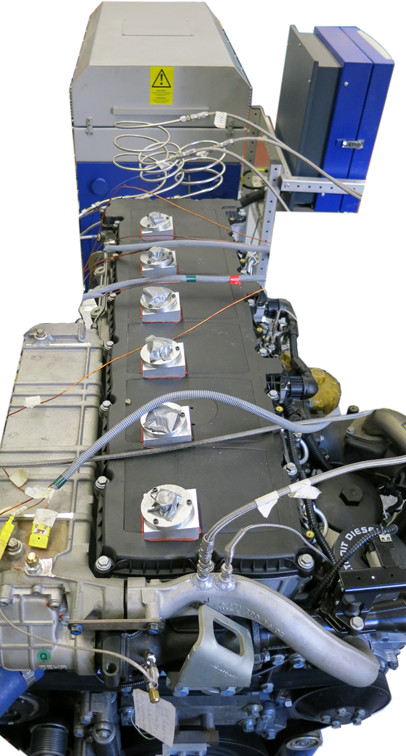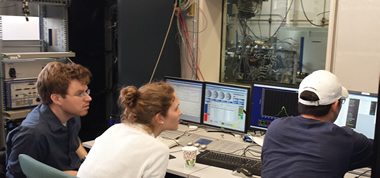Sensor-instrumented DD13 Heavy Duty Diesel Engine with AVL Dynamometer

Control room of heavy duty test cell
From left: Mike Hand, Laura Olesky, Doohyun Kim

ARC Heavy Duty Diesel Engine • Angela Violi and Jason Martz • Combined simulation and experiments, focused on understanding the chemical/physical causes of cetane number variation in JP-8, development of an improved JP-8 kinetic mechanism and chemical surrogate(s).
DDC Onboard Diagnostics and Controls • Anna Stefanopoulou, Jason Martz, Laura Olesky • Real time controls for fuel variability with advanced sensing • Diagnostics and On-board Calibration of EGR Recirculation
This facility is a critical piece of the Automotive Research Center's (ARC) vehicle R&D efforts, specifically of advanced heavy-duty diesel technology powertrains that require a highly dynamic alternating current (AC) dyamometer and completely integrated individual sub-systems, test devices, instruments and controls. This integrated hardware-in-the-loop test bed allows us to marry the computational modeling and simulation tools developed in the ARC with real world powertrain technologies through a rigorous, high fidelity experiment/simulation/validation cycle.
Manufacturer: Detroit Diesel Corporation
(click for full details)
Configuration: Inline 6 Cylinder
Displacement: 12.8 L (781 cu. in.)
Low Speed: AVL PUMA Open
High Speed: Indimaster 672 Advanced, 16 Channels
ECU Calibration: Vector CANape
Dynamometer: AVL APA 404/4,2PO
Absorbing Rating:
Nominal Power: 440 kW
Nominal Torque: 2801 Nm
Motoring Rating:
Nominal Power: 396 kW
Nominal Torque: 2521 Nm
Maximum Speed: 4200 rpm
Mass Inertia: 4.53 kgm2
Weight: 2750 kg
Bench: AVL SESAM i60 FT Multi Component Exhaust Measurement System
Analyzers:
FTIR spectrometer (NO, NO2, N2O, NH3, CO, CO2, CH4, etc.);
FID to measure total hydrocarbons (THC);
PMD for oxygen measurement (O2);
IRD to determine CO2 concentration of exhaust gas recirculation (EGR);
AVL Smoke Meter for soot measurement
A dSpace PX20 system equipped with a a DS1006 processor, a DS2202 HIL I/O board, and a DS4302 CAN interface enables real-time simulations in closed-loop with the engine test cells. This allows for performing engine-in-the-loop experiments with different types of simulated vehicles, powertrain architectures, and control strategies efficiently.
Sensor-instrumented DD13 Heavy Duty Diesel Engine with AVL Dynamometer

Control room of heavy duty test cell
From left: Mike Hand, Laura Olesky, Doohyun Kim
